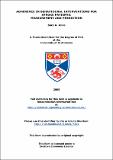Files in this item
Adherence in behavioural interventions for stroke patients : measurement and prediction
Item metadata
| dc.contributor.advisor | Johnston, Marie | |
| dc.contributor.author | Joice, Sara A. | |
| dc.coverage.spatial | xviii, 308 p. | en_US |
| dc.date.accessioned | 2015-08-18T09:04:15Z | |
| dc.date.available | 2015-08-18T09:04:15Z | |
| dc.date.issued | 2005 | |
| dc.identifier | uk.bl.ethos.548605 | |
| dc.identifier.uri | https://hdl.handle.net/10023/7262 | |
| dc.description.abstract | Background: With the increasing incidence in stroke and the resultant high prevalence of residual disability resources are not adequately meeting the needs of the patients. Furthermore patients continue to express dissatisfaction with their care. New interventions are being developed and evaluated. However, when offered these new interventions, patients may refuse or not participate fully. A stroke workbook intervention was developed through a line of research examining the role of perceived control in recovery. During the randomised controlled trial (RCT) evaluating its efficacy patients failed to fully participate in the activities proposed in the workbook. Why, when there is such a dearth of treatment available, do stroke patients not fully participate in or adhere to the interventions offered? Methods: Three studies were conducted, a predictive study using the intervention group of the RCT exploring the demographic, clinical and psychological factors predicting adherence; a predictive study using one of the intervention groups from a larger 2x2 RCT to examine the predictors of adherence to an easier intervention (video); and a third longitudinal study examining the efficacy of an even simpler intervention (letter) on increasing adherence to the video. The theoretical framework of Leventhal’s Self Regulation Model was used to develop the letter intervention and to explain the findings. Results: Five types of adherence behaviours emerged from the three studies, all with their own difficulties of definition, measurement and their individual predictor variables. Gender, impairment and illness representations were all predictive of adherence. An easier intervention promoted adherence especially for men and the more impaired. Women appeared to adhere more readily to the complex intervention. These gender differences may be associated with illness representations. A theoretical-based letter does not increase adherence per se but may increase the amount of adherence to an easier intervention. Conclusion: Adherence behaviour is not one type of behaviour and is associated with measurement difficulties. The Self-Regulation model appeared to offer some logical explanations to the findings. The findings have clinical implications and could possibly be associated with patients’ satisfaction with care. | en_US |
| dc.language.iso | en | en_US |
| dc.publisher | University of St Andrews | |
| dc.rights | Creative Commons Attribution-NonCommercial-NoDerivatives 4.0 International | |
| dc.rights.uri | http://creativecommons.org/licenses/by-nc-nd/4.0/ | |
| dc.subject.lcc | R727.43J7 | |
| dc.subject.lcsh | Patient compliance | en_US |
| dc.subject.lcsh | Cerebrovascular disease--Patients--Psychology | en_US |
| dc.subject.lcsh | Medicine and psychology | en_US |
| dc.title | Adherence in behavioural interventions for stroke patients : measurement and prediction | en_US |
| dc.type | Thesis | en_US |
| dc.type.qualificationlevel | Doctoral | en_US |
| dc.type.qualificationname | PhD Doctor of Philosophy | en_US |
| dc.publisher.institution | The University of St Andrews | en_US |
This item appears in the following Collection(s)
Except where otherwise noted within the work, this item's licence for re-use is described as Creative Commons Attribution-NonCommercial-NoDerivatives 4.0 International
Items in the St Andrews Research Repository are protected by copyright, with all rights reserved, unless otherwise indicated.


